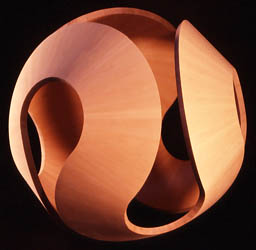|
Times Colonist July 11, 2002
THE ARTIST AS MATHEMATICIAN
"Built up from wedge-shaped units to produce sweeping
curves and delicate edges, the final forms appear to
exceed the intrinsic possibilities of mere wedges."
Elias Wakan lives in the woods on Gabriola Island. His house is full of
geometric sculptures — folded paper forms and larger wooden constructions. “I’m
into math,” he admits. “And geometry too. I like abstract forms.”
After majoring in math and philosophy at Stanford, Wakan worked as a
journeyman carpenter. A cut finger got him out of that line of work and into a
series of other businesses. Then, during two years in Japan with his wife Naomi,
he took 6,000 photographs. These were sold professionally to agencies, which led
to book design projects, which led to a career in publishing.
We returned from Japan to see Expo `86, only to find that the B.C. Ministry
of Education had decided that all Grade 6 students in B.C. should study Japan,”
Wakan recalls. Using Elias’s photographs as a base, they gave school
presentations and went on to publish Naomi’s writing on Japanese themes.
“In Japan, I didn’t do any origami,” he laughs. Their traditional style
always involves organic forms — cranes and frogs and so on — which he considers
“too arbitrary to interest my pedestrian, pedantic mind.”
During that time Elias didn’t have a woodworking shop, but began to create
with white Lanagravure paper. Each folded piece takes its form and strength from
the multitude of similarly-formed triangles that partition the surface. “It
takes awhile for your hands to get used to how far you can bend it without
creasing,” Wakan reflects. With a mat knife and some dental tools he made
manifest his geometric fancies.
Those years in the city led to visits to Gabriola. As Wakan recalls, “lining
up on Sunday to return to Vancouver was like returning from day parole to
prison.” After they moved, on quiet island days the artist found himself
admiring the way the shadows fell on his paper foldings, and wondering what they
would look like in wood.
Basically his technique is to cut hundreds of little pieces of hemlock to
precise lengths and bevels — each identical or a mirror-image. He then assembles
them using masking tape to see what form the geometry can assume. Of course
precise geometrical and mathematical imagining is involved before he gets to
work on his obsessively fine woodworking. Then comes the patient and meticulous
assembling and gluing of the parts. The results owe something to M. C. Escher’s
drawings and Antonio Gaudi’s architecture.
The hemlock wood he uses has a story. Cut from the finest B. C. timber, it is
milled in Richmond for an exacting Japanese customer. Wakan is able to buy the
planks deemed “seconds.” From the plank rejected for a knot in the middle Wakan
cuts two perfect shorter pieces.
I copied the following paragraph from Wakan’s extensive website to show you
how a mathematician/artist thinks: “Now, it's fine to have accuracies to the
closest 100,000th of a degree, but some practical woodworking concerns were to
make things more approximate. For instance, rather than trying to cut a large
amount of identical isosceles triangular wedges (with 4.00457° bevels on each
long side), it was much easier to start with long cuboids and divide them in
two, resulting in right angled wedges. After tilting the blade 8.00914° off
vertical - twice the earlier angle (which, because of the nature of the
tablesaw's blade bevel adjustment mechanism, could indeed be set very
accurately) - each piece was cut in two on the diagonal, resulting in
mirror-image, wedge-shaped pieces, with one side cut at 81.99086° and the other
cut at 90°.”
“What I do is so tedious,” Wakan acknowledges. Fortunately, the hemlock has
no pitch and doesn’t gum up his sawblade, making it easier to cut accurate
angles. And it has the tight grain and even colouring he requires. His table saw
and 10 inch tilting arbour saw are calibrated to a nicety, and sawdust is
rigorously extracted.
The cut pieces, marked and kept in meticulous order, are painstakingly
preassembled with masking tape to determine if his calculations and fabrications
have been correct. Then, using an environmentally safe, water-resistant
carpenter’s glue, Wakan glues and clamps every piece individually. When ordinary
clamps can’t get into the spaces he has created, he fabricates his own, often
using split bits of plastic tubing.
All that technique is just a means to an end. “It’s the form that I love,”
Wakan insists. “It’s so sensuous.” Elias Wakan’s paper sculpture, wood sculpture
and photography will be on display at Gabriola’s Artworks Gallery in the Folklife Village, (250-247-7412) from July 18 to 24. His large wood sculptures
can be seen over the same period at his studio, Drumbeg House, 3085 Mander Rd.,
Gabriola (250-247-0014)
His Web site is www.island.net/~prp. |
 |
|
|
July 11, 2002